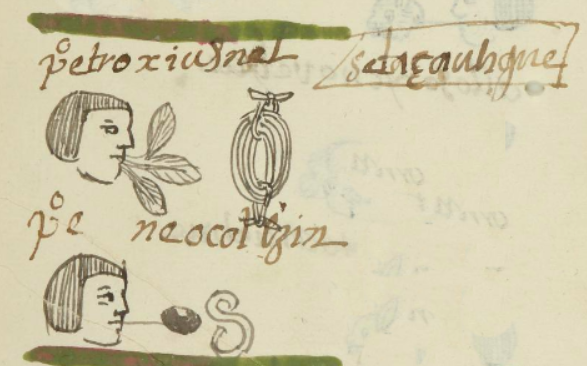sedatzauhqui (MH643r)
This black-line drawing of the simplex glyph for sedatzauhqui, the occupation of silk spinners (partially a loanword from Spanish), shows a hank of silk (seda) thread that is secured at the top and bottom with ties.
Stephanie Wood
The Spanish loanword “seda” (silk) is coming to play in the gloss, combined with tzauhqui, “spinner” or “weaver.” Silk making, a Spanish introduction, was an important industry in the second half of the sixteenth century parts of Mexico. It experienced a boom in the Mixteca, in Oaxaca, as shown in the Codex Sierra-Texupan. There are tiny pockets in the Mixteca where Indigenous women still make silk thread, feeding mulberry leaves to the silk worms. I have witnessed this personally.
Stephanie Wood
sedaçauhgue
sedatzauhqui
1560
Jeff Haskett-Wood
silk industry, hilo de seda, hilos, oficio

seda, silk (a loanword from Spanish), https://nahuatl.wired-humanities.org/content/seda
tzauhqui, spinner or weaver, https://nahuatl.wired-humanities.org/content/tzauhqui
sedatzauhqui, one who spins silk thread, https://nahuatl.wired-humanities.org/content/sedatzauhqui
las personas que hacen seda
Stephanie Wood
Matrícula de Huexotzinco, folio 643r, World Digital Library, https://www.loc.gov/resource/gdcwdl.wdl_15282/?sp=368&st=image
This manuscript is hosted by the Library of Congress and the World Digital Library; used here with the Creative Commons, “Attribution-NonCommercial-ShareAlike 3.0 License” (CC-BY-NC-SAq 3.0).


